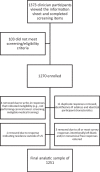Examining the association of clinician characteristics with perceived changes in cervical cancer screening and colposcopy practice during the COVID-19 pandemic: a mixed methods assessment
- PMID: 37656169
- PMCID: PMC10473834
- DOI: 10.7554/eLife.85682
Examining the association of clinician characteristics with perceived changes in cervical cancer screening and colposcopy practice during the COVID-19 pandemic: a mixed methods assessment
Abstract
Background: The COVID-19 pandemic led to reductions in cervical cancer screening and colposcopy. Therefore, in this mixed method study we explored perceived pandemic-related practice changes to cervical cancer screenings and colposcopies.
Methods: In 2021, a national sample of 1251 clinicians completed surveys, including 675 clinicians who performed colposcopy; a subset (n=55) of clinicians completed qualitative interviews.
Results: Nearly half of all clinicians reported they were currently performing fewer cervical cancer screenings (47%) and colposcopies (44% of those who perform the procedure) than before the pandemic. About one-fifth (18.6%) of colposcopists reported performing fewer LEEPs than prior to the pandemic. Binomial regression analyses indicated that older, as well as internal medicine and family medicine clinicians (compared to OB-GYNs), and those practicing in community health centers (compared to private practice) had higher odds of reporting reduced screening. Among colposcopists, internal medicine physicians and those practicing in community health centers had higher odds of reporting reduced colposcopies. Qualitative interviews highlighted pandemic-related care disruptions and lack of tracking systems to identify overdue screenings.
Conclusions: Reductions in cervical cancer screening and colposcopy among nearly half of clinicians more than 1 year into the pandemic raise concerns that inadequate screening and follow-up will lead to future increases in preventable cancers.
Funding: This study was funded by the American Cancer Society, who had no role in the study's design, conduct, or reporting.
Keywords: HPV; cervical cancer prevention; cervical cancer screening; epidemiology; global health; none.
© 2023, Fuzzell et al.
Conflict of interest statement
LF, NB, HF, PL, AM, AW, SR, MM, SV, RP No competing interests declared
Figures



Update of
- doi: 10.1101/2023.01.11.23284437
Similar articles
-
Examining the perceived impact of the COVID-19 pandemic on cervical cancer screening practices among clinicians practicing in Federally Qualified Health Centers: A mixed methods study.Elife. 2023 Sep 4;12:e86358. doi: 10.7554/eLife.86358. Elife. 2023. PMID: 37664989 Free PMC article.
-
Pan-Canadian survey on the impact of the COVID-19 pandemic on cervical cancer screening and management: cross-sectional survey of healthcare professionals.Elife. 2023 Jun 28;12:e83764. doi: 10.7554/eLife.83764. Elife. 2023. PMID: 37377399 Free PMC article.
-
A cross-sectional survey examining clinician characteristics, practices, and attitudes associated with adoption of the 2019 American Society for Colposcopy and Cervical Pathology risk-based management consensus guidelines.Cancer. 2023 Sep 1;129(17):2671-2684. doi: 10.1002/cncr.34838. Epub 2023 May 23. Cancer. 2023. PMID: 37221653
-
Early Welsh cervical screening programme learning as a consequence of the coronavirus pandemic.Cytopathology. 2022 May;33(3):350-356. doi: 10.1111/cyt.13091. Epub 2022 Jan 11. Cytopathology. 2022. PMID: 34935223 Review.
-
European consensus statement on essential colposcopy.Eur J Obstet Gynecol Reprod Biol. 2021 Jan;256:57-62. doi: 10.1016/j.ejogrb.2020.06.029. Epub 2020 Aug 23. Eur J Obstet Gynecol Reprod Biol. 2021. PMID: 33171418 Review.
Cited by
-
Factors associated with willingness to perform expedited excisional treatment for patients at high risk for cervical precancer.Gynecol Oncol Rep. 2024 Dec 9;57:101545. doi: 10.1016/j.gore.2024.101545. eCollection 2025 Feb. Gynecol Oncol Rep. 2024. PMID: 39811829 Free PMC article.
References
-
- Almeida CM, Rodriguez MA, Skootsky S, Pregler J, Steers N, Wenger NS. Cervical cancer screening overuse and underuse: patient and physician factors. The American Journal of Managed Care. 2013;19:482–489. - PubMed
-
- Arbyn M, Verdoodt F, Snijders PJF, Verhoef VMJ, Suonio E, Dillner L, Minozzi S, Bellisario C, Banzi R, Zhao F-H, Hillemanns P, Anttila A. Accuracy of human papillomavirus testing on self-collected versus clinician-collected samples: a meta-analysis. The Lancet. Oncology. 2014;15:172–183. doi: 10.1016/S1470-2045(13)70570-9. - DOI - PubMed

